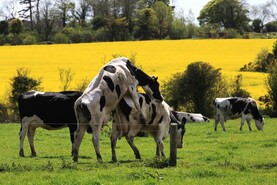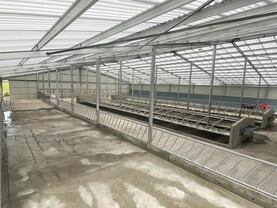Lime: With most cows now housed, cubicle hygiene is critical in the effort to prevent mastitis. This is particularly important for those considering selective dry cow therapy, even where cows are still milking.
It’s not just the cubicles that need to be clean, the cleanliness of passageways and walkways also have a big bearing. The Rolls Royce of cubicle hygiene is where passageways and walkways are cleaned every few hours and cubicle beds are scraped down twice a day, with fresh bedding applied daily. When passageways are clean there is less contamination of cubicle beds and they stay clean for longer.
On the type of bedding material, a blend of ground and hydrated lime seems to work well on Irish farms. Hydrated lime has a higher pH than ground limestone. It’s very caustic, which kills bacteria. However, it can sometimes be hard on cows’ teats and legs and so no more than one fistful per cubicle is recommended when used on its own. Blends of ground and hydrated cubicle lime are available at between 10% and 30% hydrated lime. Some farmers, particularly those with outdoor cubicles, will spray cubicle beds with liquid disinfectants instead of applying a dry product like lime.
In this week’s Machinery section there is a full report on the different mechanical options available for cleaning and disinfecting cubicle beds and passageways. How practical these machines are where primarily dry cows are housed needs to be considered before making a purchase.
Teat sealing: While teat sealing of milking cows is now common practice with or without a dry cow antibiotic, more farmers appear to be using teat sealant on heifers. While not an antibiotic, it is a licensed product and should only be used in conjunction with veterinary advice. In my view the practice of teat sealing heifers has a role to play where housing is challenged, such as slatted sheds or stand-off pads, and where there is a history of blind quarters or mastitis in heifers in early lactation.
Most farmers who do it tend to be happy with the results, but if there is no pre-existing issue then it should not be considered as it might do more harm than good. The best time to do it is six to eight weeks prior to calving, so anytime from early December for most spring-calving heifers.
Hygiene and safety are critical. Make sure teats are spotlessly clean and heifers are well restrained. There are specialists available with turnover crates who will come to the yard and carry out the procedure.
Investment: At this stage farmers will have a fair idea what, if any, free cash will be left for re-investment into the business. I would prioritise: 1) rainy day fund, 2) labour-saving equipment; 3) areas with a high return such as genetics and soil fertility; 4) upskilling yourself and any employees. Some of these issues will be discussed on virtual Dairy Day, broadcast free on www.farmersjournal.ie next Tuesday at 11am, 2pm and 8pm.
Lime: With most cows now housed, cubicle hygiene is critical in the effort to prevent mastitis. This is particularly important for those considering selective dry cow therapy, even where cows are still milking.
It’s not just the cubicles that need to be clean, the cleanliness of passageways and walkways also have a big bearing. The Rolls Royce of cubicle hygiene is where passageways and walkways are cleaned every few hours and cubicle beds are scraped down twice a day, with fresh bedding applied daily. When passageways are clean there is less contamination of cubicle beds and they stay clean for longer.
On the type of bedding material, a blend of ground and hydrated lime seems to work well on Irish farms. Hydrated lime has a higher pH than ground limestone. It’s very caustic, which kills bacteria. However, it can sometimes be hard on cows’ teats and legs and so no more than one fistful per cubicle is recommended when used on its own. Blends of ground and hydrated cubicle lime are available at between 10% and 30% hydrated lime. Some farmers, particularly those with outdoor cubicles, will spray cubicle beds with liquid disinfectants instead of applying a dry product like lime.
In this week’s Machinery section there is a full report on the different mechanical options available for cleaning and disinfecting cubicle beds and passageways. How practical these machines are where primarily dry cows are housed needs to be considered before making a purchase.
Teat sealing: While teat sealing of milking cows is now common practice with or without a dry cow antibiotic, more farmers appear to be using teat sealant on heifers. While not an antibiotic, it is a licensed product and should only be used in conjunction with veterinary advice. In my view the practice of teat sealing heifers has a role to play where housing is challenged, such as slatted sheds or stand-off pads, and where there is a history of blind quarters or mastitis in heifers in early lactation.
Most farmers who do it tend to be happy with the results, but if there is no pre-existing issue then it should not be considered as it might do more harm than good. The best time to do it is six to eight weeks prior to calving, so anytime from early December for most spring-calving heifers.
Hygiene and safety are critical. Make sure teats are spotlessly clean and heifers are well restrained. There are specialists available with turnover crates who will come to the yard and carry out the procedure.
Investment: At this stage farmers will have a fair idea what, if any, free cash will be left for re-investment into the business. I would prioritise: 1) rainy day fund, 2) labour-saving equipment; 3) areas with a high return such as genetics and soil fertility; 4) upskilling yourself and any employees. Some of these issues will be discussed on virtual Dairy Day, broadcast free on www.farmersjournal.ie next Tuesday at 11am, 2pm and 8pm.






 This is a subscriber-only article
This is a subscriber-only article










SHARING OPTIONS: